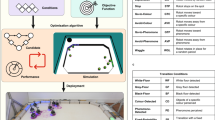Abstract
We describe our research in using environmental visual landmarks as the basis for completing simple robot construction tasks. Inspired by honeybee visual navigation behavior, a visual template mechanism is proposed in which a natural landmark serves as a visual reference or template for distance determination as well as for navigation during collective construction. To validate our proposed mechanism, a wall construction problem is investigated and a minimalist solution is given. Experimental results show that, using the mechanism of a visual template, a collective robotic system can successfully build the desired structure in a decentralized fashion using only local sensing and no direct communication. In addition, a particular variable, which defines tolerance for alignment of the structure, is found to impact the system performance. By decreasing the value of the variable, system performance is improved at the expense of a longer construction time. The visual template mechanism is appealing in that it can use a reference point or salient object in a natural environment that is new or unexplored and it could be adapted to facilitate more complicated building tasks.
Similar content being viewed by others
References
Bayindir, L., Sahin, E., 2009. Modeling Self-Organized Aggregation in Swarm Robotic Systems. IEEE Swarm Intelligence Symp., p.88–95. [doi:10.1109/SIS.2009.4937849]
Berman, S., Lindsey, Q., Sakar, M.S., Kumar, V., Pratt, S.C., 2011. Experimental study and modeling of group retrieval in ants as an approach to collective transport in swarm robotic systems. Proc. IEEE, 99(9):1470–1481. [doi:10.1109/JPROC.2011.2111450]
Bonabeau, E., Theraulaz, G., Deneubourg, J., Franks, N.R., Rafelsberger, O., Joly, J., Blanco, S., 1998. A model for the emergence of pillars, walls and royal chambers in termite nests. Phil. Trans. R. Soc. Lond. B, 353(1375):1561–1576. [doi:10.1098/rstb.1998.0310]
Camazine, S., Franks, N.R., Sneyd, J., Bonabeau, E., Deneubourg, J.L., Theraulaz, G., 2001. Self-Organization in Biological Systems. Princeton University Press, Princeton, NJ, USA.
Collett, T.S., Collett, M., 2002. Memory use in insect visual navigation. Nat. Rev. Neurosci., 3(7):542–552. [doi:10.1038/nrn872]
Collett, T.S., Graham, P., Durier, V., 2003. Route learning by insects. Curr. Opin. Neurobiol., 13(6):718–725. [doi:10.1016/j.conb.2003.10.004]
Fry, S.N., Wehner, R., 2005. Look and turn: landmark-based goal navigation in honey bees. J. Exp. Biol., 208(20):3945–3955. [doi:10.1242/jeb.01833]
Hartley, R.I., Zisserman, A., 2004. Multiple View Geometry in Computer Vision (2nd Ed.). Cambridge University Press, Cambridge, UK. [doi:10.1017/CBO9780511811685]
Kelly, J., Zhang, H., 2006. Combinatorial Optimization of Sensing for Rule-Based Planar Distributed Assembly. Proc. IEEE/RSJ Int. Conf. on Intelligent Robots and Systems, p.3728–3734. [doi:10.1109/IROS.2006.281754]
Kube, C.R., Zhang, H., 1993. Collective robotics: from social insects to robots. Adapt. Behav., 2(2):189–218. [doi:10.1177/105971239300200204]
Kube, C.R., Parker, C.A., Wang, T., Zhang, H., 2005. Biologically Inspired Collective Robotics. In: de Castro, L.N., von Zuben, F.J. (Eds.), Recent Developments in Biologically Inspired Computing. Idea Group Publlishing, New York, p.369–397.
Ladley, D., Bullock, S., 2005. The role of logistic constraints in termite construction of chambers and tunnels. J. Theor. Biol., 234(4):551–564. [doi:10.1016/j. jtbi.2004.12.012]
Melhuish, C., Welsby, J., Edwards, C., 1999. Using Templates for Defensive Wall Building with Autonomous Mobile Ant-like Robots. Proc. Towards Intelligent Mobile Robots.
Parker, C.A.C., Zhang, H., 2006. Collective robotic site preparation. Adapt. Behav., 14(1):5–19. [doi:10.1177/105971230601400101]
Parker, C.A.C., Zhang, H., 2009. Cooperative decisionmaking in decentralized multiple-robot systems: the best-of-n problem. IEEE/ASME Trans. Mechatron., 14(2):240–251. [doi:10.1109/TMECH.2009.2014370]
Parker, C.A.C., Zhang, H., 2011. Biologically inspired collective comparisons by robotic swarms. Int. J. Robot. Res., 30(5):524–535. [doi:10.1177/0278364910397621]
Parker, C.A.C., Zhang, H., Kube, C.R., 2003. Blind Bulldozing: Multiple Robot Nest Construction. Proc. IEEE/RSJ Int. Conf. on Intelligent Robots and Systems, 2:2010–2015.
Payton, D., Estkowski, R., Howard, M., 2005. Pheromone Robotics and the Logic of Virtual Pheromones. In: Sahin, E., Spears, W. (Eds.), Swarm Robotics. Springer Berlin/Heidelberg, p.45–57.
Purnamadjaja, A.H., Russell, R.A., 2010. Bi-directional pheromone communication between robots. Robotica, 28(1):69–79. [doi:10.1017/S0263574709005591]
Skibniewski, M., 2000. New Directions and Developments in Robotics and Site Atomation in the U.S.A. Proc. 17th ISARC, p.k3–k14.
Stewart, R.L., Russell, R.A., 2006. A distributed feedback mechanism to regulate wall construction by a robotic swarm. Adapt. Behav., 14(1):21–51. [doi:10.1177/105971230601400104]
Terada, Y., Murata, S., 2004. Automatic Assembly System for a Large-Scale Modular Structure—Hardware Design of Module and Assembler Robot. Proc. IEEE/RSJ Int. Conf. on Intelligent Robots and Systems, 3:2349–2355.
Theraulaz, G., Bonabeau, E., Deneubourg, J.L., 1998. The origin of nest complexity in social insects. Complexity, 3(6):15–25. [doi:10.1002/(SICI)1099-0526 (199807/08)3:6〈15::AID-CPLX3〉3.3.CO;2-M]
Theraulaz, G., Gautrais, J., Camazine, S., Deneubourg, J.L., 2003. The formation of spatial patterns in social insects: from simple behaviours to complex structures. Phil. Trans. R. Soc. Lond. A, 361(1807):1263–1282. [doi:10.1098/rsta.2003.1198]
Wawerla, J., Sukhatme, G.S., Mataric, M.J., 2002. Collective Construction with Multiple Robots. Proc. IEEE/RSJ Int. Conf. on Intelligent Robots and Systems, 3:2696–2701. [doi:10.1109/IRDS.2002.1041677]
Werfel, J., Nagpal, R., 2008. Three-dimensional construction with mobile robots and modular blocks. Int. J. Robot. Res., 27(3–4):463–479. [doi:10.1177/0278364907084984]
Werfel, J., Bar-Yam, Y., Rus, D., Nagpal, R., 2006. Distributed Construction by Mobile Robots with Enhanced Building Blocks. Proc. IEEE Int. Conf. on Robotics and Automation, p.2787–2794. [doi:10.1109/ROBOT.2006.1642123]
Recommended reading
Werfel, J., Ingber, D.E., Nagpal, R., 2007. Collective Construction of Environmentally-Adaptive Structures. Proc. IEEE/RSJ Int. Conf. on Intelligent Robots and Systems, p.2345–2352.
Werfel, J., Nagpal, R., 2008. Three-dimensional construction with mobile robots and modular blocks. Int. J. Robot. Res., 27(3–4):463–479. [doi:10.1177/0278364907084984]
Kelly, J., Zhang, H., 2006. Combinatorial Optimization of Sensing for Rule-Based Planar Distributed Assembly. Proc. IEEE/RSJ Int. Conf. on Intelligent Robots and Systems, p.3728–3734. [doi:10.1109/IROS.2006.281754]
Petersen, K., Nagpal, R., Werfel, J., 2011. TERMES: an Autonomous Robotic System for Three-Dimensional Collective Construction. Proc. Robotics: Science and Systems.
Bonabeau, E., Theraulaz, G., Deneubourg, J., Franks, N.R., Rafelsberger, O., Joly, J., Blanco, S., 1998. A model for the emergence of pillars, walls and royal chambers in termite nests. Phil. Trans. R. Soc. Lond. B, 353(1375):1561–1576. [doi:10.1098/rstb.1998.0310]
Author information
Authors and Affiliations
Corresponding author
Additional information
Project (No. 61075091) supported by the National Natural Science Foundation of China
Rights and permissions
About this article
Cite this article
Zhang, Zw., Zhang, H. & Li, Yb. Biologically inspired collective construction with visual landmarks. J. Zhejiang Univ. - Sci. C 13, 315–327 (2012). https://doi.org/10.1631/jzus.C1100243
Received:
Revised:
Published:
Issue Date:
DOI: https://doi.org/10.1631/jzus.C1100243




